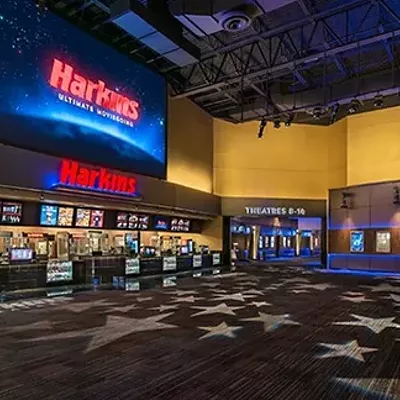While project planners insist that nothing about the generally well-received Rio Nuevo master plan is etched in stone, one of its most controversial aspects is an outdoor amphitheater seating 3,000 with parking for 1,000 cars. This $2 million facility would be located south of Congress Street on the west side of I-10 and is proposed to be built within the next five years.
Rick Gibson, a local advisor to the Nederlander Organization, which has built several amphitheaters around the country, thinks the idea has merit. He's had informal discussions with city officials about the idea over the past two years and hopes to work something out at the Rio Nuevo site. But, he says, the facility should be considerably larger than that being proposed.
With an amphitheater holding up to 10,000 people or more, Gibson says, "Tucson could have the kind of entertainment which we have to go elsewhere for now." Plus, he adds, while the smaller facility would be a financial drain on city coffers, a larger venue would be a tax revenue-generating business.
The people who live near the proposed amphitheater site, however, are not impressed by even the City's smaller concept. Which isn't surprising, since this isn't the first time they have heard about it.
Fifteen years ago, the idea popped up to turn the abandoned rock quarry in "A" Mountain into an amphitheater that would seat 13,000 to 15,000 people. World Entertainment Services, Inc. proposed spending $5 million on the project, which would have included a large stage, dressing rooms, and parking for 3,200 cars. According to a newspaper article at the time, the amphitheater "received heated opposition from westside residents."
Local planner Carl Winters, who served as a consultant for that proposal, remembers the response differently. He recalls the neighborhood reaction to the idea was mixed. "Some people in Menlo Park neighborhood (north of the site) supported the idea," he says, "but the Kroger Lane neighborhood (south of it) was opposed. Those people who owned businesses in the area also tended to be supportive."
Whatever the nearby residents' reaction to the proposal, the idea went nowhere. To provide parking for the facility, World Entertainment Services needed to lease and then rezone adjacent property from the City of Tucson. Although both City Parks Director Jim Ronstadt and City Manager Joel Valdez backed the idea, the City Council tabled it, and the proposal eventually just faded away.
Plans for the current amphitheater proposal may be heading down the same path. At a meeting last week of the Rio Nuevo Multipurpose Facilities District Board, several speakers voiced strong opposition to the idea. Alfredo Gonzales, secretary of the Menlo Park Neighborhood Association, said, "It will bring a huge amount of people and disturbance into our neighborhood. It will be very intrusive and that is why we are unanimously opposed to it."
After hearing those fears, the Rio Nuevo board unanimously adopted a recommendation to the Tucson City Council that construction of the amphitheater be delayed for at least 10 years. Gonzales thinks that's a very positive step.
Rick Gibson says that he still hopes to work something out. He indicates he understands and respects the concerns of the surrounding neighborhoods, but believes the facility can be designed to be sensitive to them. "As an operator, you can't have people unhappy with the facility," Gibson says. "You don't want problems." Then he adds, "Under the right conditions, an amphitheater could be an exciting addition to the community. But the neighbors must be happy with it. If they're not happy, it's not a good business to run."
At the same meeting, the Rio Nuevo board also suggested the City Council set aside $9 million over the next decade for improvements in the neighborhoods located around the Rio Nuevo site. Board member Corky Poster said the City conducted its past urban renewal program at the expense of these neighborhoods, so this would be a way of giving something back to them. He suggested that sidewalks, streetlights and infill housing projects could be accomplished with the funds.
WHILE THE CITY council will review the current plans for Rio Nuevo on Monday, it will also discuss the preparation of an agreement between the City and these neighborhoods that is intended to establish "some certainty as to the future of the downtown barrios." If the past is any indication, those neighborhoods can be certain that their futures will always be in doubt because of the implementation of the Rio Nuevo project.
The story of the 1960s destruction of much of Tucson's barrio has been well documented. To make room for the urban renewal development of the downtown government complex and the Tucson Convention Center, hundreds of primarily Hispanic households were moved before their adobe homes were demolished.
A tale that isn't as well known is what happened to a small neighborhood, El Membrillo, which is tucked between I-10 and the TCC. Twenty years ago, about 25 homes were nestled along Sentinel Street south of Congress.
To try to preserve the residential quality of the area and bring more housing into the neighborhood, the City had a plan prepared, including a series of physical improvements along with proposed zoning changes.
Unfortunately, most of those recommendations were never accomplished. Instead, the widening of the I-10 frontage road combined with the expansion of parking for the TCC has resulted in residential demolition becoming the primary activity in the area. Twenty years after the El Membrillo plan was prepared, only 14 homes remain.
It wasn't supposed to be that way. The neighborhood plan suggested the encouragement of new residential construction through both infill development on empty lots and the acquisition of an adjacent large parcel of vacant property for new housing. Instead, that parcel became a parking lot for the Convention Center. During the same period, only one new house has been built in the neighborhood, but at least a few others have been rehabilitated.
The plan also recommended laying in sidewalks, installing a landscape buffer and building a noise-abatement wall next to I-10. The latter project was implemented as part of widening the frontage road, but the other proposals were never completed.
Based on the City's failure to protect and improve the El Membrillo neighborhood, current downtown residents who live near the proposed Rio Nuevo project might be concerned about City efforts to provide them some certainty about their future.
As the earlier case showed, the City often just doesn't deliver on its promises.
The Rio Nuevo public hearing will be held at 7:30 p.m. on Monday, February 26, at the Leo Rich Theater in the Tucson Convention Center, 260 S. Church Avenue.










